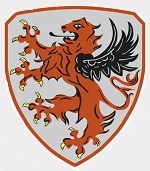Corgi US32112 German Messerschmitt Bf 109E "Emil" Fighter - Herbert Ihlefeld, I./Lehrgeschwader 1, Battle of Britain, 1940 (1:72 Scale)
"Guns before butter. Guns will make us powerful; butter will only make us fat."
- Reichsmarschall Hermann Goering, Head of the German Luftwaffe
 Numerically the most abundant fighter produced by either side during WWII, the Messerschmitt Bf 109 formed the backbone of the Jagdwaffe on both the eastern and western fronts, as well as in the Mediterranean and North Africa. Of the eight distinct sub-types within the huge Bf 109 family, the most populous was the G-model, of which over 30,000 were built between 1941-45. Despite its production run, only a handful of genuine German Bf 109s have survived into the 1990s, and with the serious damaging of the RAFs G-2 at Duxford in October 1997, only the German-based MBB G-6 and Hans Ditte's G-10 (both composites) are currently airworthy.
Numerically the most abundant fighter produced by either side during WWII, the Messerschmitt Bf 109 formed the backbone of the Jagdwaffe on both the eastern and western fronts, as well as in the Mediterranean and North Africa. Of the eight distinct sub-types within the huge Bf 109 family, the most populous was the G-model, of which over 30,000 were built between 1941-45. Despite its production run, only a handful of genuine German Bf 109s have survived into the 1990s, and with the serious damaging of the RAFs G-2 at Duxford in October 1997, only the German-based MBB G-6 and Hans Ditte's G-10 (both composites) are currently airworthy.
In late 1938, the Bf 109E entered production. To improve on the performance afforded by the 441-515 kW (600-700 PS) Jumo 210, the larger, longer Daimler-Benz DB 601A engine was used, yielding an extra 223 kW (300 PS) at the cost of an additional 181 kg (400 lb). A much bigger cooling area was needed to disperse the extra heat generated by the DB 601, and this led to the first major redesign of the basic airframe. Enlarging the existing nose-mounted radiator sufficiently to cool the engine would have created extra weight and drag, negating some of the performance gains afforded by the increased power, so it was decided to move the main radiators to the under surfaces of the wings immediately outboard of the junction of the wing root and wing panel, just forward of the trailing edges' inner ends, leaving the oil cooler under the nose in a small, streamlined duct. The new radiator position also had the effect of counterbalancing the extra weight and length of the DB 601, which drove a heavier three-bladed Vereinigte Deutsche Metallwerke (VDM)-made propeller.
To incorporate the new radiators, the wings were almost completely redesigned and reinforced, with several inboard ribs behind the spar being cut down to make room for the radiator ducting. Because the radiators were mounted near the trailing edge of the wing, coinciding with the increased speed of the airflow accelerating around the wing camber, cooling was more effective than that of the Jumo-engined 109s, albeit at the cost of extra ducting and piping, which was vulnerable to damage. The lowered undercarriage could throw up mud and debris on wet airfields, potentially clogging the radiators. To test the new 1,100 PS (1,085 hp, 809 kW) DB 601A engine, two more prototypes (V14 and V15) were built, each differing in their armament. While the V14 was armed with two 7.92 mm (.312 in) MG 17s above the engine and one 20 mm MG FF in each wing, the V15 was just fitted with the two MG 17s mounted above the engine. After test fights, the V14 was considered more promising and a pre-production batch of 10 E-0 was ordered. Batches of both E-1 and E-3 variants were shipped to Spain for evaluation, and first saw combat during the final phases of the Spanish Civil War.
Pictured here is a 1:72 scale replica of a German Messerschmitt Bf 109E "Emil" fighter that was piloted by Herbert Ihlefeld, which was attached to I./Lehrgeschwader 1, then participating in the Battle of Britain during 1940.
Sold Out!
Dimensions:
Wingspan: 5-1/4-inches
Length: 5-inches
Release Date: August 2009
 Historical Account: "Training for Duty" - Lehrgeschwader 1 (LG 1) (Learning Wing 1) formerly Lehrgeschwader Greifswald was a Luftwaffe multi-purpose unit during World War II, operating fighter, bomber and dive-bomber Gruppen. The unit was formed in July 1936. The unit operated most of the prominent German aircraft during the conflict, such as the Messerschmitt Bf 109, Messerschmitt Bf 110, Dornier Do 17, Heinkel He 111, Junkers Ju 88 and Junkers Ju 87.
Historical Account: "Training for Duty" - Lehrgeschwader 1 (LG 1) (Learning Wing 1) formerly Lehrgeschwader Greifswald was a Luftwaffe multi-purpose unit during World War II, operating fighter, bomber and dive-bomber Gruppen. The unit was formed in July 1936. The unit operated most of the prominent German aircraft during the conflict, such as the Messerschmitt Bf 109, Messerschmitt Bf 110, Dornier Do 17, Heinkel He 111, Junkers Ju 88 and Junkers Ju 87.
The unit was created to control the Lehrgruppe in the Luftwaffe. Stab/LG 1 was formed in July 1936, and on April 1st,1937, the Stab Gruppe was officially created along with I.(leichte Jagd), II.(schwere Jagd), III.(Kampf) and IV.(Stuka) Gruppen.


